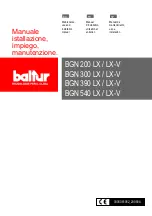
48
The indoor unit, outdoor unit and thermostat comprising a ComfortNet
system “communicate” digitally with one another, creating a two-
way communications path. The thermostat still sends commands to
the indoor and outdoor units. However, the thermostat may also
request and receive information from both the indoor and outdoor
units. This information may be displayed on the ComfortNet ther-
mostat. The indoor and outdoor units also interact with one an-
other. The outdoor unit may send commands to or request informa-
tion from the indoor unit. This two-way digital communications
between the thermostat and subsystems (indoor/outdoor unit) is
the key to unlocking the benefits and features of the ComfortNet
system.
Two-way digital communications is accomplished using only two wires.
The thermostat and subsystem controls are powered with 24 VAC.
Thus, a maximum of 4 wires between the equipment and thermo-
stat is all that is required to operate the system.
A
IRFLOW
C
ONSIDERATIONS
A
irflow demands are managed differently in a communicating
system than they are in a non-communicating wired system.
The system operating mode (as determined by the thermostat)
determines which unit calculates the system airflow demand.
If the furnace is responsible for determining the airflow de-
mand, it calculates the demand and sends it to the ECM motor.
If the outdoor unit or thermostat is responsible for determin-
ing the demand, it calculates the demand and transmits the demand along with a fan request to the indoor unit. The
furnace then sends the demand to the ECM motor. The following table lists the various ComfortNet systems, the operating
mode, and airflow demand source.
For example, assume the system is an air conditioner matched with a furnace. With a call for low stage cooling, the air
conditioner will calculate the system’s low stage cooling airflow de-
mand. The air conditioner will then send a fan request along with
the low stage cooling airflow demand to the furnace. Once received,
the furnace will send the low stage cooling airflow demand to the
ECM motor. The ECM motor then delivers the low stage cooling air-
flow. See the applicable ComfortNet air conditioner or heat pump
installation manual for the airflow delivered during cooling or heat
pump heating.
In continuous fan mode, the CTK0* thermostat provides the airflow
demand. The thermostat may be configured for one of three con-
tinuous fan speed settings allow for 25%, 50% or 75% airflow, based
on the furnaces’ maximum airflow capability. During continuous fan
operation, the thermostat sends a fan request along with the con-
tinuous fan demand to the furnace. The furnace, in turn, sends the demand to the ECM motor. The ECM motor delivers the
requested continuous fan airflow.
F
OSSIL
F
UEL
A
PPLICATIONS
This furnace can be used in conjunction with a ComfortNet™ compatible heat pump in a fossil fuel application. A fossil fuel
application refers to a combined gas furnace and heat pump installation which uses an outdoor temperature sensor to determine the
most cost efficient means of heating (heat pump or gas furnace). When used with the CTK0* thermostat, the furnace/heat pump
system is automatically configured as a fossil fuel system. The balance point temperature may be adjusted via the CTK0*
thermostat advanced user menus (see CTK0* instructions for additional information).
CTKO* 1 & 2
Thermostat
ComfortNet Compatible Furnace
Integrated Control Module
ComfortNet Compatible AC/HP
Integrated Control Module
System Wiring using Four-Wires
1
2
R
C
1
2
R
C
1
2
R
C
System
System Operating
Mode
Airflow Demand Source
Cooling
Air Conditioner
Heating
Furnace
Continuous Fan
Thermostat
Cooling
Heat Pump
Heat Pump Heating
Only
Heat Pump
Auxiliary Heating
Furnace
Continuous Fan
Thermostat
Cooling
Furnace
Heating
Furnace
Continuous Fan
Thermostat
F Non-
Comm 1stg Air
Conditioner
Air Conditioner +
Furnace
Heat Pump +
Furnace















































